Welcome to the third installment of my series on deck building for newer players. If you wish to read the previous installments, you can take a look at The Most Consistent Card In Your Deck (an article on choosing and weighing Identities) and Giving Your Deck Enough Credit (an article on the choosing and importance of economy). If you’ve already read these, or simply wish to start reading here, welcome! Lets get into it.
As I was writing the last article on economy, I kept thinking that I might be jumping the gun on getting people to think about how much economy they need when I haven’t even covered the other deck essentials. However, I thought it was an important enough point to impress upon people that I went ahead with it (seriously though, make sure you have enough money in your deck). Now we’ll be getting into the cards that form the basic interactions in a game of Netrunner: ICE and Icebreakers. This is what you’ll probably be spending a large amount of all that money on.
The basic structure of a game of Netrunner involves the Corporation making and defending servers with ICE, while the runner attacks them, usually using Icebreakers in order to pass the ICE and access the cards within said servers. That’s where the simplicity ends, though. There are vast amounts of ICE and breakers in the game of Netrunner, and choosing how many of what type of ICE or breakers as well as which specific ones (and how many of each of them) can be fairly confusing to newer players — and honestly it can frustrate the rest of us as well. It’ll be my job to hopefully make this process at least a little less frustrating.
From here, I’m going to split up into two separate sections: one talking about the Corp and their ICE, and one talking about the runner, and what to use to break said ICE. I’ll do the corp first in order to breed familiarity with the different ICE and their types, as well as their various styles and degrees of penetrability. This way, once I move onto chatting about the runner and Icebreakers, we’ll already be caught up on what the corp is doing and how best to stop them.
Corp and ICE
There are three main subtypes of ICE in Netrunner, and those types are Barrier, Code Gate, and Sentry. We’ll pick apart what they do later, but for now just remember that
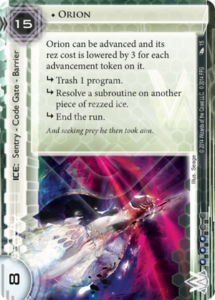 Orion gets to be all 3 subtypes!
Orion gets to be all 3 subtypes!
these are the main three. There are many other subtypes of ICE, but those are almost always found in conjunction with these three main types. Within a normal corp deck, you almost always want all three types of ICE. This is usually because you want to make the runner guess what kind of ICE you have face down protecting your servers. If you only run Barriers, for example, there’s no mystery to your ICE, and the runner knows that they will only ever need to look for and install their Fracter in order to beat you. It might be cute to only run one type with the idea that the runner doesn’t know what ICE are in your deck, so they won’t know you’re only runner barriers, but this only works if you only play against a person one time in your life. The next time you play them, they’re wise to your antics. Another reason to have multiple ICE types in your deck is to simply make the runner find and install their breakers. This costs them clicks and credits, and your usual goal is to make sure they have as few of either of those as you can make happen. Even a simple Vanilla that makes the runner go and find their Paperclip made them spend however long it took them to find it, as well as 4 credits to install, and 1 credit to break for the rest of the game. That’s a super value for 0 credits and an install.
Beyond printed types of ICE, the Netrunner community at large has further broken down ICE into other categories. One of these categories is referred to as Binary ICE. Binary ICE is simply ICE that specifically ends the run, such as Ice Wall or Rototurret. You either pay to pass it, or you don’t pass it; thus the binary aspect of it. Other ICE that doesn’t specifically fire End The Run subroutines doesn’t actually stop the runner; the runner simply suffers the consequences of the printed subs and moves on through, assuming they can’t break it.
There isn’t really a specific term for non-binary ICE other than… well, non-binary. Non-binary ICE includes ICE like Neural Katana or Resistor. Resistor has the ability to end the run, but since it’s a trace subroutine, the runner can chose to pay through it, and is therefore considered non-binary.
Now that I’ve briefly given this overview, I’m going to give out a hard truth about ICE in Netrunner. Most ICE don’t ever fire their subroutines. If you’re lucky, an ICE might fire it’s subs once a game, as the runner is running without Icebreakers to make you rez your ICE, or if they guess wrong on what Icebreaker they needed, considered the risks involved, and ran anyhow. The rest of the time — the majority, in fact — is that ICE usually just gets broken. That sick Brainstorm over your remote that you plan on rezzing and killing the runner’s entire grip for all time? It’s probably just going to cost the runner a few credits instead. Sure, you might get them to run it early and it’ll fire, and man that’s a sweet feeling. That’s not the way life usually goes.
Let’s look at the shape of a game of Netrunner and see how the ICE functions throughout it. There are three phases to the game. In the early game, you are trying to protect your servers and get some money in order to rez the ICE you need. This is a good time for the runner, since they can poke around without any breakers, or with minimal protection, like a Self-Modifying Code, and make you rez your ICE, threatening accesses if you don’t or can’t. This is also a time when ICE will often fire, since the runner is poking around trying to see what you’ll do. Eventually, you have some money and now it’s the runner who needs to find their breakers to get past the ICE you now have installed as you try and push out agendas. This phase of the game, the mid-game, is where you are strongest. As the runner struggles to find what they need, you can score a few points and maybe get ahead. Eventually, though, they will find all their breakers and can get in your servers. This is phase 3 of the game, and so long as the runner has enough money, they can get in wherever they want. Almost all the ICE does at this point in the game does is simply tax the runner credits, and the only time ICE fires is if the runner decides that’s firing the ICE is more economical than breaking it.
This is why you need to have a game plan for your ICE and for your deck. If it is your goal to be a rush deck — that is, a deck that plans to score out completely before the runner gets set up, you’re going to want quite a lot of binary ICE of all 3 types. If this isn’t your goal, then you are probably going to want ICE that can tax the runner out. When I talk about taxing the runner, what that means is that your ICE is able to drain the runner’s money as they’re running your servers.
As an example, if your R&D ICE is a Vanilla, an Enigma, and a Neural Katana (7 total to rez, and 3 total to install), then a runner with a Paperclip, a Gordion Blade, and a Mimic are going to be breaking that server for 4 credits total (3 credits if they run on their last click, or don’t mind losing a click to Enigma). Compare that to a server with just a DNA Tracker (8 to re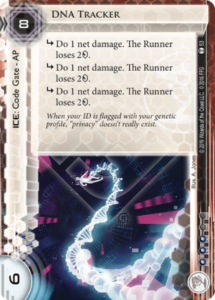 z, 0 to install). If the runner is breaking with that same breaker suite, then it’s going to cost them 7 credits total. This server cost you 1 more to rez, but costs the runner almost twice as many credits per run in order to access cards, which is a great return. Also keep in mind that the first server also made the runner install all of their breakers, which is a not-insubstantial cost in clicks and credits.
z, 0 to install). If the runner is breaking with that same breaker suite, then it’s going to cost them 7 credits total. This server cost you 1 more to rez, but costs the runner almost twice as many credits per run in order to access cards, which is a great return. Also keep in mind that the first server also made the runner install all of their breakers, which is a not-insubstantial cost in clicks and credits.
This isn’t to say that you can only run taxing ICE in a deck and just rely on the runner being too poor to access cards. If you plan on scoring agendas in a remote, and don’t have some binary ICE in order to stop them, the runner always has the option of just running through your ICE and suffering the consequences. If it nets them an agenda, it might be worth it. If it gets them their final agenda, it always is. After all, it doesn’t matter how much brain damage the runner has if they won the game (and didn’t die from said brain damage on the way to victory).
Examining this, we can extrapolate that your remote needs at least 1 piece of Binary ICE at the end of it in order to stop the runner from just running in and taking your things. Technically, it only needs 1 — the rest can be good taxing ICE that will punish the runner for running on it, only to be stopped at the end. Once the runner finds the proper icebreaker, this can lead to the same potential issue as the first case, where the runner takes the punishment of the outer ICE and breaks the inner one. In the end, ICE alone often can’t win the game by itself, and if it’s your goal to score within a server, you might want to consider upgrades to help protect your agendas (which I’ll cover in an upcoming article on Win Conditions).
Things can be different on central servers. Keeping the runner out of centrals with binary ICE is good, but really, R&D and HQ protect themselves somewhat simply because the runner relies on random accesses in order to score an agenda, rather than that 100% chance you just gave them when you installed and advanced that Oaktown Renovation in your server. Because of this, it can be fine to install ICE that taxes the runner for their accesses instead of always needing hard ETR ICE.
My main point about this is that you usually need a mix of both binary and non-binary, taxing ICE in most decks. You want to have enough ETR ICE in order to keep the runner out of key servers early and start scoring, meaning you need to have enough in order to drawn them consistently, but that usually shouldn’t be all that you include.
Finally, let’s take a look at ICE subtypes. There are three that you’ll see most commonly. Overall, the most benign of them are the Barriers. These usually are the binary, ETR ICE, often with one or more ETR subs. Additional ETR subs don’t really do anything beyond the first, but they do provide a hard barrier of entry for the runner, insofar as they need to be able to break all the ETR subs in order to get in. Barriers usually don’t get many interesting subs, but with cards like IP block and Tithonium, that may be changing. Sentries are traditionally the most threatening, and usually contain punishing subroutines, such as damage, trash program subs, and subs that can threaten the runner’s board state in other ways. These often end up being some of the taxing ICE included in a deck, because while you often can run through them without breaking them, there is often a high price for doing so. Finally, we come to the Code Gates. Code Gates are kind of a grab bag, when it comes to subroutines. It seems like if there’s a subroutine that isn’t damage, trashing, or ETR (although could be found in conjunction with one of these), than the ICE is probably a Code Gate.
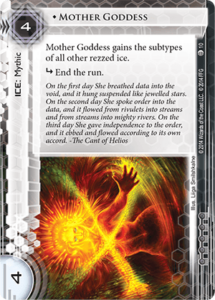 There is another two subtypes of ICE that appear on their own as well, but they’re usually much more rare. Those types are Mythic, and Trap. These types of ICE force the runner to have unique solutions to answering them, or otherwise have to deal with them firing. As an example, a lone Mother Goddess can keep a runner with out a solution away from a server forever, so long as no other ICE are rezzed.
There is another two subtypes of ICE that appear on their own as well, but they’re usually much more rare. Those types are Mythic, and Trap. These types of ICE force the runner to have unique solutions to answering them, or otherwise have to deal with them firing. As an example, a lone Mother Goddess can keep a runner with out a solution away from a server forever, so long as no other ICE are rezzed.
There are other subtypes of ICE, such as Destroyer, AP, and Tracer (Destroyers trash programs, AP ICE damage the runner, and Tracers initiate a Trace), but they are always found in conjunction with other subtypes of the main types.
Lastly, a special note needs to be made for Bioroid ICE. These are special ICE that Haas-Bioroid has, and this subtype can be found in conjunction with any other base type of ICE. The special note that needs to be made about them is that, unlike any other type of ICE in the game, the runner can usually spend clicks in order to bypass subroutines on them, rather than needing a breaker. This places all Bioroid ICE in the non-binary category, even traditional binary-only ICE, such as Barriers. However, seeing as runners only have so many clicks each turn, having multiple stacked Bioroids can be extremely taxing to a runner, since, as a boost for being penetrable, they usually have higher strength and/or a larger subroutine count.
Examples are great, so I’d like to briefly look at Chris Dyer’s 2016 Worlds winning corp list, Snekbite. This list runs fewer ICE than most decks these days run, but is a slightly horizontal deck (runs many remote servers, often unprotected), and it really doesn’t need to run as many as a deck that’s trying to heavily ICE all its servers. As for Binary ICE, there’s only really 3 to speak of: the 2 Tollbooths and 1 Enigma. More often than not (probably like 95% of the time) Resistor might as well be a hard ETR as well, as paying 4 credits to get through for an access isn’t financially viable, and that’s if they don’t raise the trace strength. The rest of the ICE, though? It just steals the runner’s money, making runs cost more than the runner is probably comfortable with. Really, the deck’s entire purpose is this, and the ICE suite is chosen to reflect it. Although the deck’s ICE suite is primarily made of Code Gates, all 3 types are represented in order to make the runner install their stuff and use their money.
As a final but important note, once you place an ICE down, it’s there for the rest of the game, so try and make intelligent choices on where your ICE is going. Sometimes it’s worth delaying placing a sub-optimal ICE in front of a server and instead waiting to draw a better choice than it is having to deal with a poor ICE placement for the rest of the game.
Next, let’s look at the runner and what they need to do to get past all this.
Runner and Breakers
As I said in my last article, Netrunner is effectively a war between two credit pools, so breaking efficiently is absolutely key to maintaining aggression and tempo. What you generally want out of your breaker suite is the ability to handle most commonly played ICE without too much hassle. Efficiency is really the name of the game.
There are breakers that are just plain bad because they don’t break commonly used ICE with any kind of efficiency. There are also breakers that are amazing against ICE of a certain strength, but pretty bad at others. As an example, let’s look at Sunny’s breaker, GS Sherman M3.
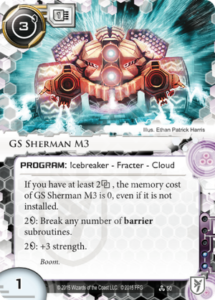 The literal picture of inefficiency.
The literal picture of inefficiency.
Sherman only has a strength of 1, and pumps at 2 credits for 3 strength, but breaks an infinite amount of subroutines for 2 credits. While the break cost might seem great, it is poor vs single-sub ICE, and the pump cost can often be awkward, especially given its already-kinda-low base strength of 1. This makes even Ice Wall 2 to break, which is great for a 1-cost ICE, and 4 to break if the corp advances that Ice Wall even just once. Barriers traditionally don’t have tons of subs either, so the 2-for-infinity break cost is often irrelevant. Spiderweb has 3 subs, but a strength of 2, so it still takes 4 credits to break. Really, the best case scenario ICE would be an early game Hive with 5 subs. Sherman is at it’s best here, since it’s a 3 Str ICE, so the 2 to pump 3 ratio is good enough here, only needing to be pumped once and not wasting much extra strength, and the 2 credits to break 5 subs is fantastic. Again, it costs 4c total, but that’s still very good compared to almost every other breaker. The problem is that this is just one piece of ICE in the game, and almost everything else breaks poorly for Sherman. Again, efficiency is the name of the game.
Earlier I discussed the 3 main types of ICE, and there are 3 common types of breakers for those ICE. Fracters break barriers, Decoders break Code Gates, and Killers break Sentries. It doesn’t matter what other subtypes happen to be on the ICE, a Killer will always break a Sentry, even if that ICE also has a Destroyer subtype and an AP subtype. Of the three, Killers tend to be the least efficient of the bunch, seemingly by design. Given that Sentries are also the most punishing ICE to encounter, the runner needs to be able to work around these inefficiencies.
There’s another way to classify the types of breakers outside of what specific ICE they break, and this classification also has 3 types. One is regular breakers. This includes the majority of the breakers in the game, from Paperclip to Mongoose. You pay money (or occasionally some other resource); they break whatever type of ICE they’re supposed to. Then there are Stealth breakers, such as Refractor. These need some kind of stealth credit gained from a secondary source in order to power either its pump strength or its breaking. These can be very economical, since they can run off of reoccurring credits rather easily, but are also a little slower to set up since you also need this special economy of stealth credits to get them going. Finally, there are AI breakers that can break any subtype of ICE.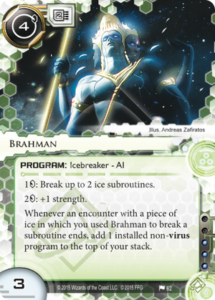 These all have some kind of restriction imposed upon them in order to lower their power level so they (hopefully) don’t get out of hand. Sometimes decks will run one of these as an emergency breaker, and sometimes decks will go all-in and have the AI breakers as their primary breakers. A couple examples of these are Aumakua and Atman.
These all have some kind of restriction imposed upon them in order to lower their power level so they (hopefully) don’t get out of hand. Sometimes decks will run one of these as an emergency breaker, and sometimes decks will go all-in and have the AI breakers as their primary breakers. A couple examples of these are Aumakua and Atman.
There are also just a few breakers that can break ICE with the non-base subtypes. Gingerbread just breaks ICE with the Tracer subtype. These types of breakers are few and far between, however, and almost never used.
When putting together a breaker suite, you mainly just want to pick the breakers with the best breaking math. Sometimes those cards are out of faction and you’ll need to pay influence for them. Sometimes those cards are out of faction and you won’t have spare influence to spend, so you’ll need to find the next best thing within your own faction. It’s fine to be a little inefficient, but you want to spend as little money as possible so that you can make more runs (and threaten to make more runs) in the future. If you know more about the environment and decks you’ll be playing against (referred to as the meta), then you can make additional choices about what you can run as a suite. Otherwise the above is a fine rubric. Oftentimes, with larger ICE such as Tollbooth and DNA Tracker, it can be prohibitively expensive to break through them repeatedly, and that’s when other tools are more necessary.
Femme Fatale, as a tool, is one way that can make a lot of sense. Rather than paying 4 credits to break Tollbooth with Gordion Blade and another 3 credits for the pleasure of looking at the ‘Booth, you can just pay 9 for Femme and bypass it for a single credit. If you end up bypassing that Tollbooth even just twice, you’re 3 credits ahead of where you would be breaking it manually, and the corp begins to feel pretty bad about the 8c they payed to rez it in the first place. D4v1d is another great tool for larger ICE, turning the ‘Booth into a 3 credit tax for 3 accesses. It’s worse against DNA Tracker, only gaining you past once, but that 3 credits that D4v1d cost is still one of the cheapest ways past. Most decks should have an answer to large ICE that isn’t “use money to break,” because that’s a short road to ruining your economy.
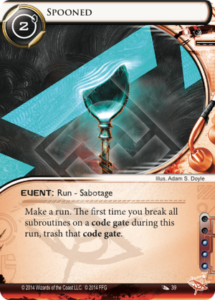 Always a good Anarch inclusion, given the popularity of painful Code Gates
Always a good Anarch inclusion, given the popularity of painful Code Gates
One of the best tools to getting past larger ICE is to destroy it. Our long friend, Parasite, no longer exists, but the Anarchs still have Knifed, Forked, and Spooned, all of which are still perfectly viable cards. This makes that lone D4v1d used to break DNA Tracker much, much better, as the one time it gets you through is the only time it is required. Derezzing, through tools, such as Rubicon Switch and Emergency Shutdown, is another option, though less permanent, and forces the corp to rez their expensive ICE another time if they can.
These last two paragraphs have nothing to do with Icebreakers, and that’s actually an important part of getting past ICE. Some of it, you really don’t want to break, you just want to deal with. As an example, lets look at Wilfy Horig’s winning Runner decklist at Worlds this year.
Before I go into the large ICE tech in the Worlds list, lets just look at their regular breakers. The deck runs Inti for Barriers, Gordian Blade for Code Gates, and Na’Not’K for sentries. Inti is, by and large, a terrible breaker for even mid-sized Barriers, given it’s 2-to-pump cost and 1 strength, but it was used because not a lot of mid-to-large barriers are being run in most decks due to the prevalence of Paperclip, which breaks most Barriers so efficiently that it’s not really worth trying to run larger Barriers. Instead, people run small ones (or, occasionally gigantic ones in the form of Chiyashi) just to make people have to find and install their barrier breaker. Inti breaks these small barriers just fine, and installs for free. Gordian is a very solid Code Gate breaker at 2 strength and a 1/1 pump/break cost. Na’Not’K is a newer card, but is very efficient at breaking sentries, especially if there are 2 or more ICE present protecting the server.
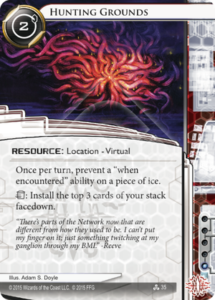 Apex has a good card, and that card is not Apex
Apex has a good card, and that card is not Apex
The tech cards for larger ICE in this deck are Femme, Atman, and occasionally Hunting Grounds. Stimhack can also count, as a free 9 credits allows you to use regular breakers to break large ICE more easily. We’ve discussed Femme, but Atman can work in a similar way. You can simply set Atman to 6, and suddenly DNA Tracker now costs just 3 to break. It can also be used on smaller ICE, if you notice that your opponent has many ICE of a similar strength, or as an emergency breaker when you just need to get in a server. I mentioned Hunting Grounds can occasionally be large ICE tech mostly in the case of Tollbooth, because it shuts off that 3c tax that the ‘Booth imposes. It also gets you by cards like Data Raven, and turns Komainu into a 5c waste of space.
Another reason for cards like this is because there are another couple types of ICE beyond the standard Barrier/Code Gate/Sentry mix. These are the Trap ICE and Mythic ICE that we discussed briefly in the Corp section. Traps are things that usually fire once and then trash themselves, like Special Offer and Lab Dog. There’s only 3 Mythic ICE at the moment, and they are Mother Goddess, Excalibur, and Kitsune. Loki is often considered a Mythic as well, as specific decks will run only Mother Goddess, Excalibur, and Loki, in order to have an ICE suite that most runner decks can’t deal with. Running things like Femme and AI breakers (and events like Inside Job) get you by these types of ICE that regular breakers can’t handle.
All in all, choosing your breaker suite is a game of choosing which breakers have the best breaking math for whatever ICE you expect to see, and then choosing a few ways to try and cheat around several of the more difficult ICE. The last real decision you now face is how many of each type should you run? The World’s deck above only ran one Fracter, one Decoder, one AI, and two Killers (with Femme being more of a tool, but still a fine breaker for low str sentries). However, he was able to do this because of a large amount of card draw in Laguna Velasco District, 2 copies of Self-Modifying Code to find specific programs, as well as the tutor engine that is Artist Colony and Fan Sites. He is able to combat program trashing through the use of Sacrificial Construct and Levy, so is comfortable with the prospect of only needing a single copy of any given program.
Criminals are often able to get away with single copies of programs as well, since they can find them through the use of Special Order, although they are more vulnerable to program trashing, so will sometimes run more Killers (since trash program subs are mostly found on Sentries) or will simply run multiple copies of breaker types. Anarchs usually just run 2 of each main type of breaker and maybe an AI breaker, as the massive amount of card draw they have available in faction makes finding them fairly reasonable. Obviously for your deck this is a decision that you will have to make on your own, and might require some testing to get right for your deck specifically, but this is a place to start if you feel unsure.
Finally, keep in mind that sometimes it is completely fine to just run through ICE and deal with the consequences. Damage often isn’t that big a deal, and even taking a couple brain damage doesn’t effect most games all that much. Icebreakers are great, but sometimes the better option is to just walk on through.
That’s All Folks!

That’s it for ICE and their breakers! There’s obviously a LOT to talk about on this subject, as it makes up a good chunk of the game of Netrunner, but hopefully this serves as a decent primer. In my next (and possibly final) article, I’ll be discussing win conditions and agenda suites. I’ll see you then!




